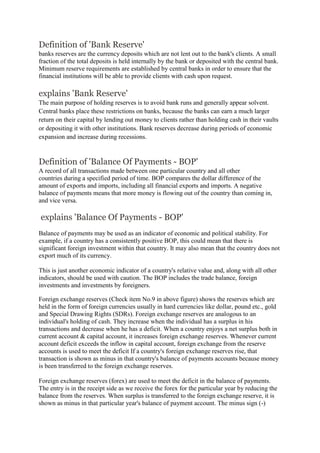
Definition of
- 1. Definition of 'Bank Reserve' banks reserves are the currency deposits which are not lent out to the bank's clients. A small fraction of the total deposits is held internally by the bank or deposited with the central bank. Minimum reserve requirements are established by central banks in order to ensure that the financial institutions will be able to provide clients with cash upon request. explains 'Bank Reserve' The main purpose of holding reserves is to avoid bank runs and generally appear solvent. Central banks place these restrictions on banks, because the banks can earn a much larger return on their capital by lending out money to clients rather than holding cash in their vaults or depositing it with other institutions. Bank reserves decrease during periods of economic expansion and increase during recessions. Definition of 'Balance Of Payments - BOP' A record of all transactions made between one particular country and all other countries during a specified period of time. BOP compares the dollar difference of the amount of exports and imports, including all financial exports and imports. A negative balance of payments means that more money is flowing out of the country than coming in, and vice versa. explains 'Balance Of Payments - BOP' Balance of payments may be used as an indicator of economic and political stability. For example, if a country has a consistently positive BOP, this could mean that there is significant foreign investment within that country. It may also mean that the country does not export much of its currency. This is just another economic indicator of a country's relative value and, along with all other indicators, should be used with caution. The BOP includes the trade balance, foreign investments and investments by foreigners. Foreign exchange reserves (Check item No.9 in above figure) shows the reserves which are held in the form of foreign currencies usually in hard currencies like dollar, pound etc., gold and Special Drawing Rights (SDRs). Foreign exchange reserves are analogous to an individual's holding of cash. They increase when the individual has a surplus in his transactions and decrease when he has a deficit. When a country enjoys a net surplus both in current account & capital account, it increases foreign exchange reserves. Whenever current account deficit exceeds the inflow in capital account, foreign exchange from the reserve accounts is used to meet the deficit If a country's foreign exchange reserves rise, that transaction is shown as minus in that country's balance of payments accounts because money is been transferred to the foreign exchange reserves. Foreign exchange reserves (forex) are used to meet the deficit in the balance of payments. The entry is in the receipt side as we receive the forex for the particular year by reducing the balance from the reserves. When surplus is transferred to the foreign exchange reserve, it is shown as minus in that particular year's balance of payment account. The minus sign (-)
- 2. indicates an increase in forex and plus sign (+) shows the borrowing of foreign exchange from the forex account to meet the deficit.